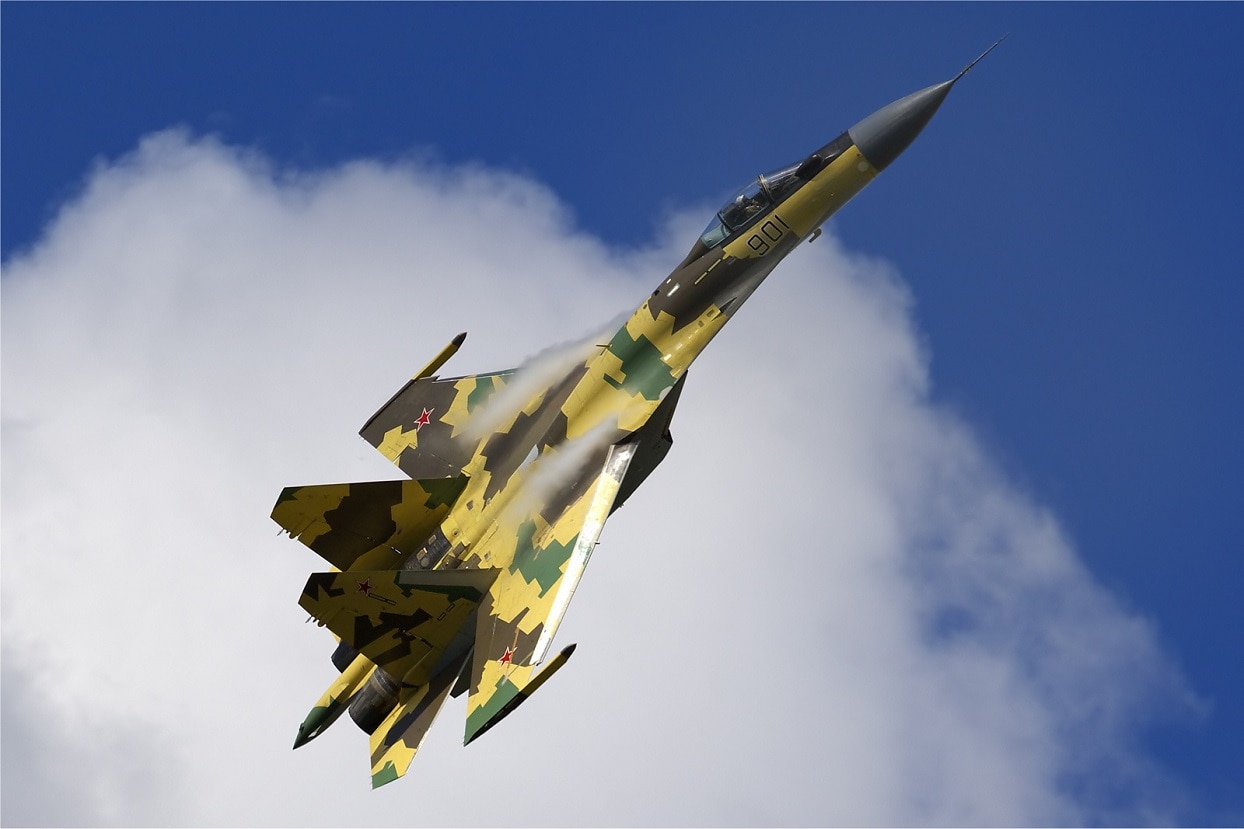The Su-35 is clearly Russia’s best fighter that has nothing to do with stealth technology. While the plane has all of the makings of an elite weapon of war, that doesn’t mean Russia has taken losses in Ukraine regarding the Su-35. And that is something Washington has capitalized on: Introduced in 2014, the Sukhoi Su-35 Flanker is an updated, improved version of the Su-27. A multirole fighter, adept in an air-defense role, the Su-35 has been used heavily in the Russo-Ukraine War.
While built from the Su-27, the Su-35 is visually distinct from its predecessor, thanks to canards – small lifting surfaces located ahead of the wings on the fuselage. The canards were added, along with a reshaped wing leading-edge extension, to redirect airflow and solve the buffeting problem that the Su-27 experienced at high angles of attack. The modifications also allow the Su-35 to endure 10-gs. The improved flight surfaces, paired with a fly-by-wire control system, have allowed the Su-35 to achieve increased maneuverability over its predecessor.
Advanced Armament
The upgraded Su-35 also features a new weapons-control system. The highlight of the new system is the N011 Bars, a phase-arrayed radar with pulse-Doppler tracking. The N011 Bars allow the MiG-35 to track targets below the horizon, which makes the jet capable of engaging ground targets. The N011 is a significant upgrade over the N001 Myech radar, used aboard the Su-27. Whereas the N001 could only track 10 targets at one time, and direct just two missiles at a target simultaneously, the N011 can track fifteen targets and fire missiles at six of them simultaneously.
Powering the Su-35 are two Saturn AL-41F1S turbofan engines. The engines are outfitted with thrust-vectoring nozzles, similar to those found on fifth-generation American fighters. The Su-35’s engine nozzles can be vectored differently from one another, allowing for supermaneuverable flight characteristics, including post-stall maneuvers, like the Pugachev’s’ Cobra. The Saturn engines provide over 30,000 pounds of thrust and enable a max speed of Mach 2.25. The jet can climb to its maximum service ceiling of 59,000 feet in just over one minute. With supercruise ability, the Su-35 has a 2,200-mile range.
The Su-35 is equipped with a variety of powerful weaponry. Internally, the jet houses one 30-millimeter Gryazev-Shipunov GSh-30-1 autocannon with 150 rounds. With 12 hardpoints, the jet can carry a 17,630 pounds payload of ordnance, including air-to-ground rockets, air-to-air missiles, air-to-surface missiles, anti-ship missiles, anti-radiation missiles, and an array of bombs.
Russia has already sold the Su-35 to China. In 2015, China spent $2 billion USD to secure 24 Su-35s. The contract took several years to hammer out, as Russia was concerned that the Chinese would reverse engineer the Su-35 – just like China had reverse-engineered the Su-27SK and Su-33 to create the J-11B and J-15 respectively. With the contract finalized, China became the first-ever recipient of the Su-35. And now, the Su-35 populates the air forces of the west’s two most important rivals.
Western intelligence was recently afforded a unique opportunity to examine the Su-35. In April 2022, a Su-35 was downed in eastern Ukraine. The Ukrainians claimed they shot the plane down. Reportedly, the Su-35’s wreckage was recovered and then taken to the Defence Science and Technology Laboratory in the United Kingdom. In the UK, British and American representatives spent several days analyzing the recovered Su-35 parts. After the initial analysis in the UK, the wreckage was packed up and transported to Nevada, where the Americans will take a closer look, to better understand Russia’s aerospace capabilities.
Harrison Kass is the Senior Defense Editor at 19FortyFive. An attorney, pilot, guitarist, and minor pro hockey player, he joined the US Air Force as a Pilot Trainee but was medically discharged. Harrison has degrees from Lake Forest College, the University of Oregon, and New York University. He lives in Oregon and listens to Dokken. Follow him on Twitter @harrison_kass.

